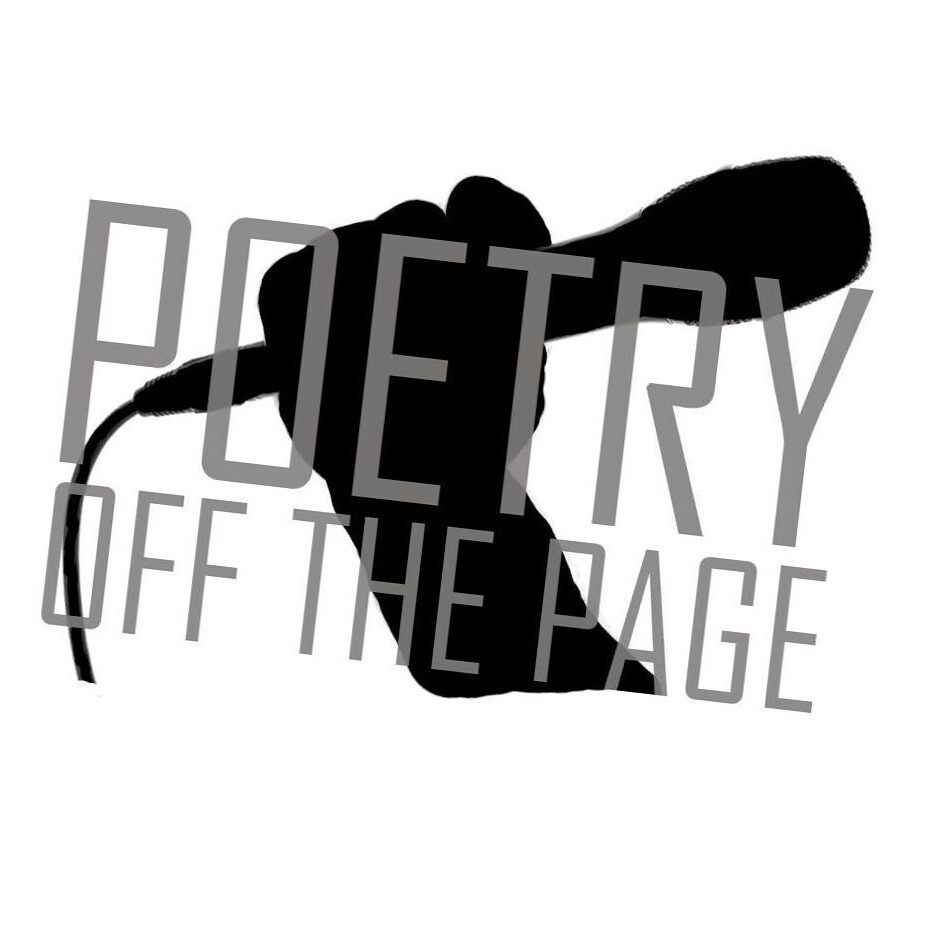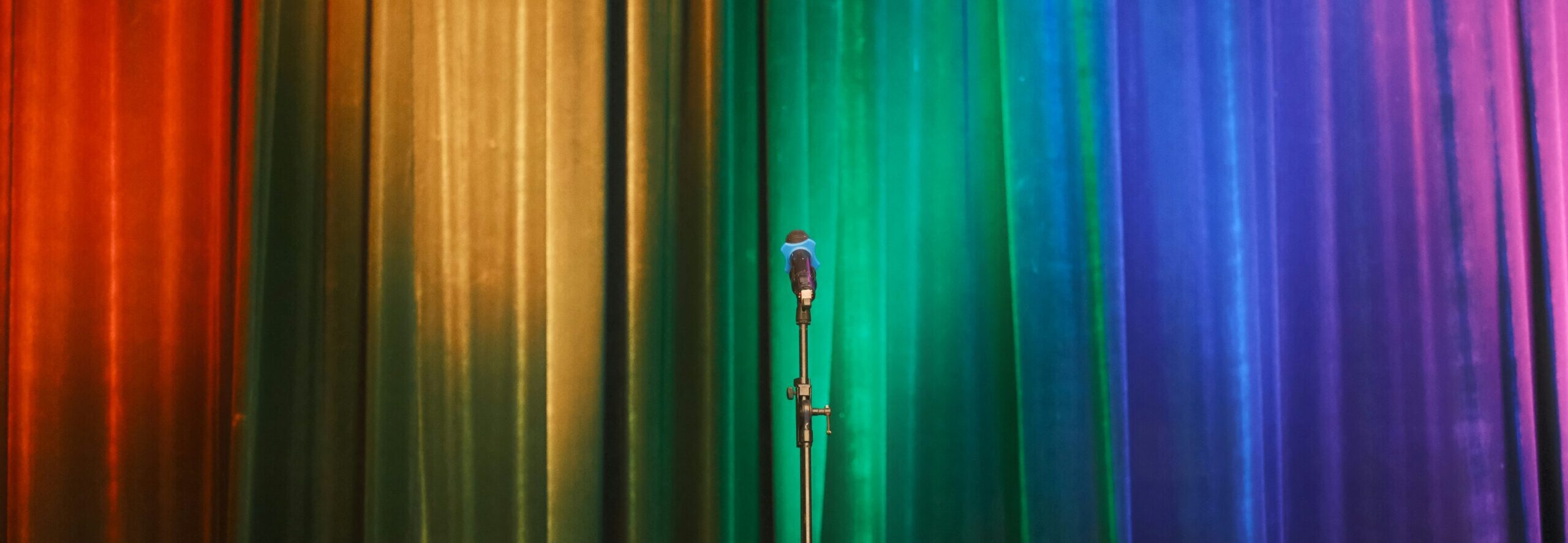by CHRISTINA MATTSON, independent researcher
Introduction
A performer stands on stage, telling jokes into a microphone to a live audience. Weaving together shorter ‘bits’ and longer narratives, they use “I” statements and delve into personal and political subjects; the audience audibly reacts to their material, alternating between laughter and applause, cheers and jeers. This description could provide a working definition of stand-up comedy; it could just as easily refer to a performance of spoken word poetry. Indeed, beyond their formal similarities, both stand-up comedy and spoken word poetry are interdisciplinary genres with porous borders, making them difficult to explicitly delineate and define.[1] Many performers lean into their similarities, performing under alternating labels of either spoken word poetry or stand-up comedy; some (for example, Rob Auton, Greg Byron, and Hal Sirowitz) are even characterised, by themselves and by reviewers, as “stand-up poets.”
A key point of connection between the genres is their incorporation of humour. While, as Oliver Double argues, only “stand-up comedy is defined by the fact that it is funny, […] Spoken Word performers do get laughs” (79), and humour has long been a prevalent element of poetry performance. Steve Larkin traces the rich and enduring history of humour within UK spoken word poetry, following the “absurd, comic, and satirical traditions that have flourished [in the UK] for such a long time” (38). While Larkin compares this tradition to a ‘heavier’ confessional style emerging from North American poetry slam spheres (30-31), Cristin O’Keefe Aptowicz notes that “humorous poetry has always been a good strategy to win over a rowdy audience” in US poetry slam (384). However, while humour is a central aspect of scholarship within stand-up comedy studies, it remains a largely under-researched element within analyses of spoken word poetry, with little methodological consideration. Further, despite their formal similarities, spoken word poetry and stand-up comedy scholarship remain distinct academic fields with little interaction. Kate Fox suggests that stand-up comedy is “a form with which [spoken word] would bear much more comparison and whose body of scholarship could produce generative comparisons and methodologies” (290-291). One such realm of potential exchange is the use of humour in poetry performance.
This blog post aims to suggest a framework for research on humour in spoken word poetry that builds from a productive dialogue between stand-up comedy and poetry performance scholarship. The first section considers how humour operates and functions within stand-up. It investigates how poetry performers generate and incorporate humour within their performances and proposes methodological tools for such examinatons. The second section works to demonstrate the usefulness of these guidelines for performing a close reading of a humorous spoken word poem: Harry Baker’s “An Ode to the Postcode.” The article concludes by suggesting future directions for analyses of humour in spoken word poetry.
I. Humour in Stand-up and Spoken Word: A Closer Look
Humour has long had a curiously tense relationship with analysis. As Elwyn B. White’s oft-cited maxim posits, “[e]xplaining a joke is like dissecting a frog. You understand it better, but it dies in the process” (xvii); something ineffable about humour is considered lost in examination. Scholars from various fields have long worked to explain how and why we find things funny and to uncover the physical and mental processes that lead to laughter. Contemporary comedy scholars generally agree that there are three main theoretical schools for understanding humour (Critchley 2-3; Morreall 4-23; Quirk 20-22). The earliest, dating back to Plato and Aristotle, is the ‘superiority theory,’ which considers humour as pleasure arising from a feeling of superiority over others, in which one is the “agent rather than the target of laughter” (Willett and Willett 7). This theory is useful for examining jokes related to hierarchies, such as instances of self-deprecation, where the speaker encourages the audience to see the performer as the ‘target’. A more physiological theory, the ‘relief theory’ conceives of humour as a physical experience of catharsis, the pleasurable release of tension resolving into laughter (Critchley 3), and is useful for examining the exchange between performer and audience. The ‘incongruity theory’ arises from a subversion of expectations and “locates humour not primarily in bodily and emotional relief but rather in the pleasant surprise that occurs through the violation of normal mental patterns and expectations” (Willett and Willett 13). As each theory considers a different element of humour, and no single theory can fully explain all of its instances, Sophie Quirk suggests that these be considered and wielded as complementary models for examining humour (20). These alternative models not only explain why an audience might find something funny but also provide useful lenses to discuss and analyse incarnations of humour. In utilising these theories, identifying a piece as ‘humorous’ does not necessarily convey a subjective judgment of funniness but rather that the work may be attempting a humorous affect through superiority, relief, and/or incongruity—the success of which is often measured in laughter.
In a stand-up comedy performance, humour is generated in multiple different ways. Within the verbal ‘material’ of the performance, humour is often created through a joke, defined as “a very specific speech act, that is, a short formulaic utterance, ending with a punch line, which produces (or is meant to produce) laughter” (Coates 30). Ian Brodie suggests that while “[j]okes should be understood more as instances of humour than as a particular form […], they often take a form, like riddle jokes, or have recurrent motifs […] and verbal patterns […] so that they are more quickly recognizable as jokes” (25). Tone, expression, and gesture can also support a joke’s humour. As Double notes, material and delivery are ideally “inseparable and indivisible, working together in perfect synthesis” (387), and that “[p]retty much the whole of a joke’s funniness can be contained in the merest gleam of an eye or the quirky way a particular word is pronounced” (386). However, Brodie crucially explains that “jokes do not provide their own resolution. The listener restores equilibrium by ‘getting it,’” but “[g]etting it differs from finding it funny” (26). The key to a joke’s success—and the elicitation of laughter—lies in the audience’s understanding that a joke is being made and that the statement is intended to be perceived as humorous. In a stand-up comedy performance, this understanding does not occur in isolation; the conventions of the genre help audiences recognise that jokes are being delivered, thus facilitating humour and encouraging laughter. Sophie Quirk borrows from Johann Huizinga’s conception of ‘playgrounds’ as spaces removed from daily life and usual methods of communication that operate under individual rules and etiquette to suggest that stand-up comedy performances create, and operate within, a frame of “play” (74). The venue of a comedy club for a live performance or the label of ‘stand-up’ for an event or recording work to establish a play-frame in which “jokers can operate outside of the restrictions which govern most regular interaction” (36). This activates “comic licence, telling the audience that it is acceptable to interpret the stories as jokes and to laugh at them” (48). Quirk stresses that “[t]he primary aim of any stand-up performance is to make the audience laugh” (13). The label of stand-up comedy plays a significant role in achieving its goal by fulfilling the essential element of ‘getting’ a joke. By positioning the audience to see the performance as intended to be humorous, it fosters an interpretation of the performance as comedic, thereby generating humour within the act.
For all of the similarities between spoken word poetry and stand-up comedy, a key site of difference is therefore perhaps not in the content of the performances, but in their framing and the expectations they carry. While spoken word poetry can and does incorporate humour, a label of spoken word poetry on a venue or recording does not necessarily engender an expectation of laughter. As Larkin acknowledges, international trends in spoken word poetry and slam are increasingly shifting toward confessional, ‘authentic’ poems, often rooted in experiences of trauma (33, 34, 37). Spoken word poetry performances do not occur in an established frame of play; for humour to be effective and to elicit laughter, performers must themselves signal and establish that comic licence is active and that their material is intended to be humorous. Crucially, the process of framing a performance is embedded within spoken word poetry conventions. “[P]aratexts,” as Julia Novak expands Gérard Genette’s term, describe “a part of the verbal audiotext that accompanies the ‘poem proper’ in the form of introductions, comments, etc” (75). As this “can have considerable effects on the audience’s experience of live poetry” (143), these elements of commentary can work to establish a frame of play for a spoken word performance, encouraging the audience to view both the poem and the entire performance as humorous. In an interesting connection to stand-up comedy, in contrast to the ‘poem proper,’ this paratextual commentary is meant to be viewed as ‘ad lib’ and improvised during performance, though remarks are often pre-planned (138). Similarly, “[m]ost stand-up performances maintain the appearance of being spontaneous” (Quirk 77). The similarities between the illusion of ‘real-time’ elements of a performance further blur the boundaries between spoken word poetry and stand-up comedy. This suggests that highlighting similarities to stand-up comedy, or invoking conventions of the genre, can encourage the enactment of comic licence within spoken word poetry. An incorporation of humorous elements in paratexts can be a key method for establishing a play frame in a poetry performance, encouraging a reception of the poem as humorous, and an incorporation of stand-up scholarship can be useful for analysing these incarnations of humour in live poetry.
II. Analysing Humour in “An Ode to the Postcode”
Using this synthesised theoretical framework, this section analyses British poet Harry Baker’s “An Ode to the Postcode,” both to examine how Baker creates and encourages humour within the performance and to serve as an example of the methodological possibilities for analysing humour within poetry performance. An award-winning spoken word poet, Baker performs poetry that ranges between philosophical, emotional, and comedic registers. He has performed “An Ode to the Postcode” in various contexts—this analysis draws on a recording of his performance at the Loud Poets x Bad Betty Press November 2023 Showcase,[2] which features Baker alongside three other poets performing multiple poems over the course of the evening. “An Ode to the Postcode” occurs roughly one third of the way through, during a “Poetry Jukebox” round in which the four featured poets stand together on stage and must volunteer a poem that fits a randomly selected category. When the category of ‘dream’ is given, Baker steps up to perform a poem he describes as written for his “dream” commission: a celebration of the concept of postcodes that must also fulfil extremely niche criteria. This performance provides a useful site of analysis for two key reasons. Firstly, as both Baker’s previously performed poem and the Jukebox poem that precedes this performance operate in more emotional and vulnerable registers, Baker must work to establish a frame of play to ensure his poem is received comedically, work which can be analysed using the preceding synthesis of stand-up comedy and spoken word poetry scholarship. Second, the performance’s humour arises from multiple different angles and can be considered alternately using the different models of humour theory discussed above.
Before the poem proper, Baker’s paratextual introductory remarks establish comic licence as active, encouraging the audience to laugh at the material that follows. This begins as he justifies his poem selection. “This poem was a commission,” he says, pressing his hand to his heart and grinning widely. He continues, “and it was the dream commission for me” (Baker 38:18-38:27).
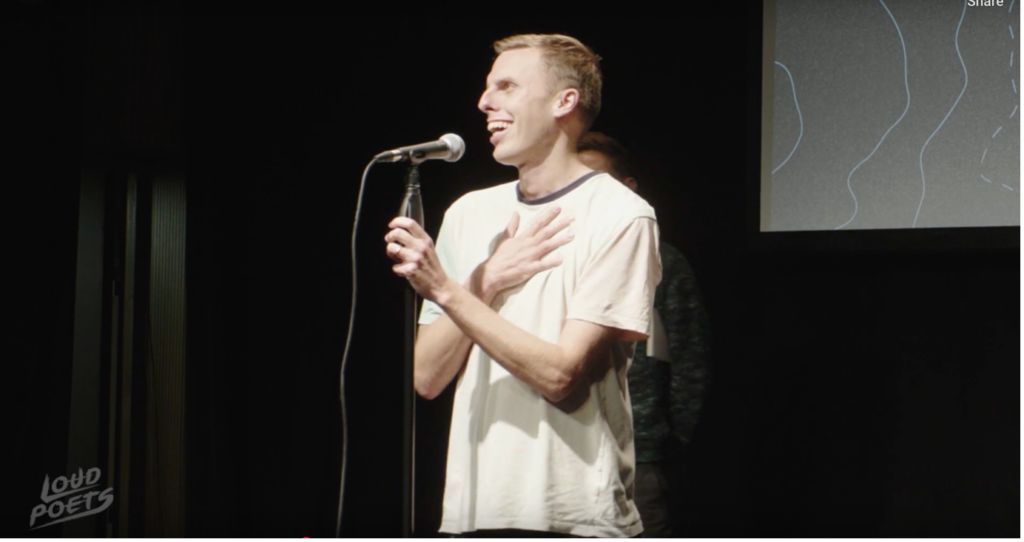
These introductory lines immediately subvert expectations; rather than fitting the prompt category ‘dream’ by way of subject, as had the previous poets, Baker proposes a connection based on his experience of writing the poem, and the exaggerated earnestness of Baker’s gestures suggest an acknowledgement of this connection as tenuous; the audience responds with laughter. Baker explains this dream commission as the request, “Can I write a poem…that makes postcodes sexy…but that also reflects the glory of God?” (Baker 38:51-38:59). His pauses (denoted here by ellipses) build dramatic tension for the increasingly surprising reveals of the commission’s niche, wildly disparate subjects, culminating in the incongruous juxtaposition of “sexy” and “the Glory of God.” The audience reacts uproariously, and he pauses again, this time a bit longer, letting the laughter linger before pressing his hands together in prayer form and saying, “Which, as we can all agree, is…the dream” (Baker 39:03-39:07).
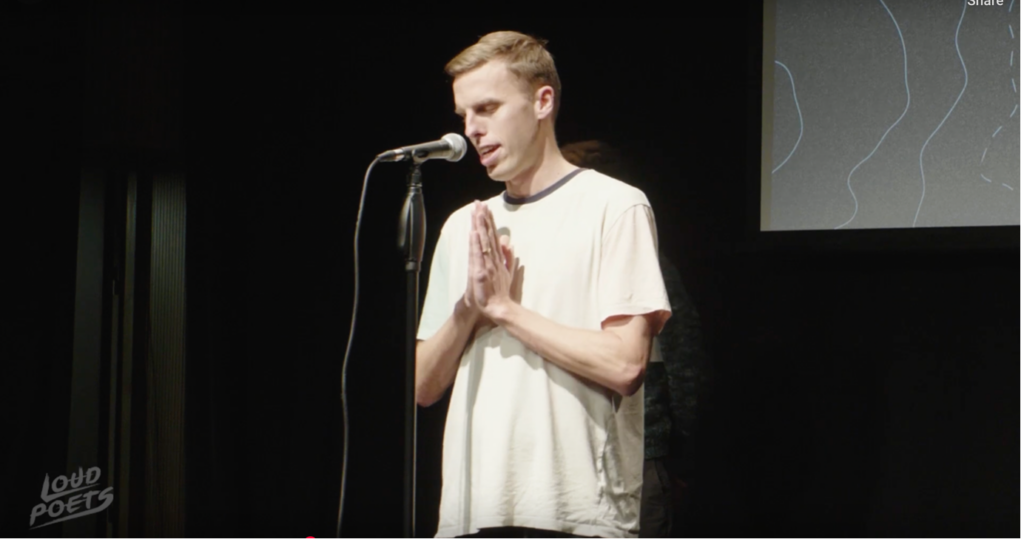
His declaration of this commission as “the dream” carries an ironically hyperbolic solemnity, encouraging the audience to laugh at the incongruous seriousness with which he approaches the subject. Baker’s paratextual introduction effectively frames the upcoming poem as a playfully grave consideration of something mundane, encouraging the audience to view the material as humorous and respond with laughter.
The instances of humour in the poem proper, occurring within this frame, can be examined using alternate humour models. Baker begins with the lines,
Some heroes wear capes
Some come dressed in Lycra
Some swing on webs
Once they’re bitten by spiders
But often the heroes are ones that we don’t know
This goes out to the unsung hero: the postcode. (Baker 39:18-39:35)
Baker again utilises pauses to build to a punchline revelation. As the audience knows the poem’s subject from the introduction, this does not necessarily subvert expectations, but the comparison of superheroes—larger-than-life, powerful, life-saving—to an inanimate and intangible administrative system is humorously incongruous. There is also an ironic layer to this incongruity: Baker seems to encourage an acknowledgement of the absurdity of the poem’s central tenet. After a series of puns built from postcode area codes and districts—such as “You might pop to Preston for the good PR” (Baker 39:52-39:56)—successively increasing in length and outlandishness, Baker says, “Or this happens all of the time/ Does a German reluctant to solve workplace conflict in Outer Herefordshire go and see HR? / Nein” (Baker 40:29-40:41). Baker delivers the “Nein” in an almost pleading tone while spreading his arms.
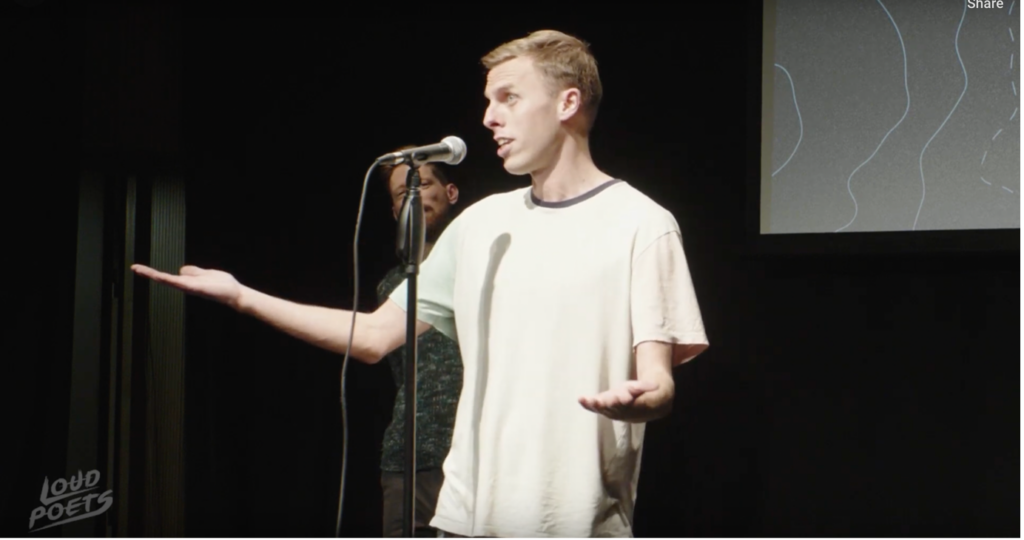
He then motions as if to continue, stops, and softly laughs to himself, looking down and shaking his head.
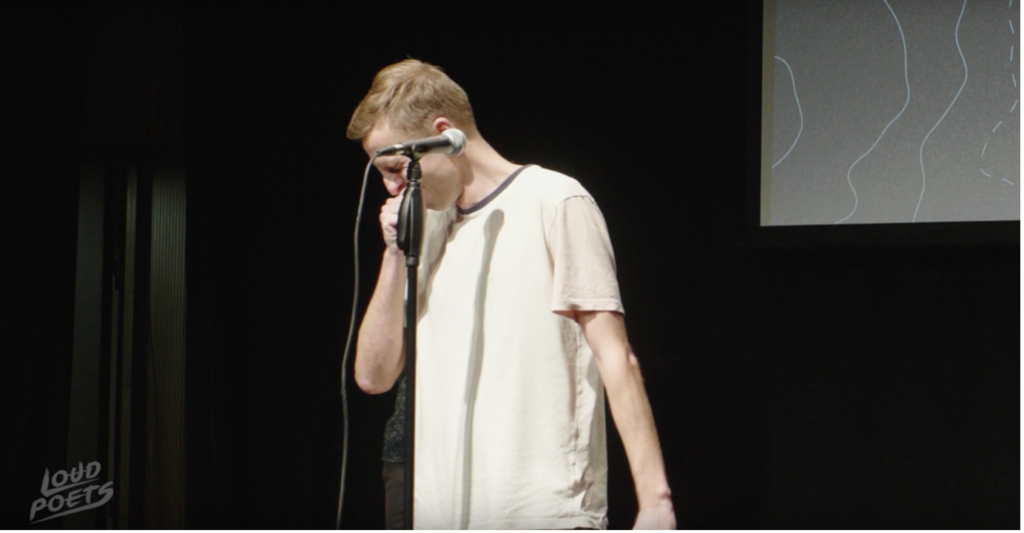
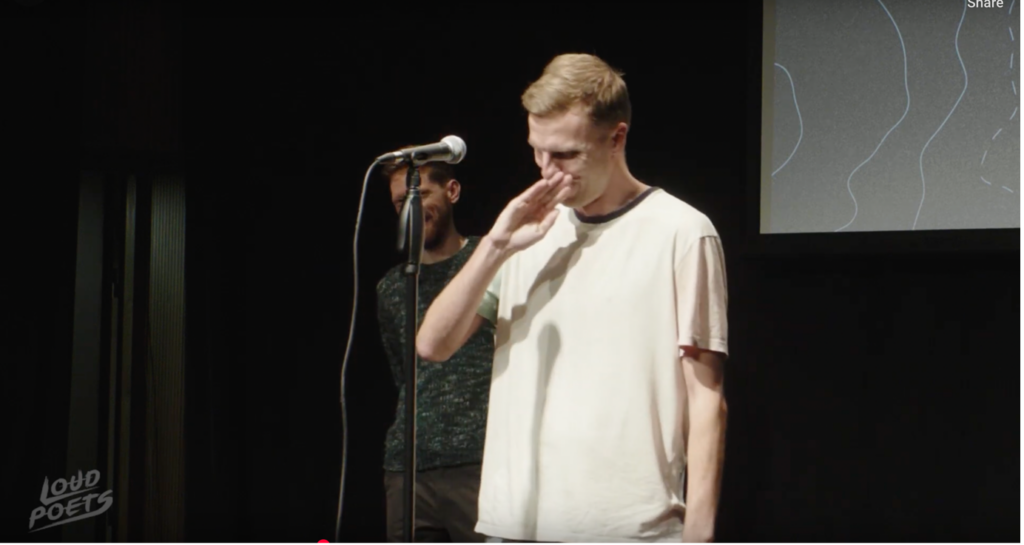
Baker’s own laughter and dismissive gestures seem to invite the audience to laugh at both the extended reach of the wordplay—emphasized by the extended length of the second cited line—and the absurdity of the poem as a whole. Viewing this through a lens of ‘superiority,’ Baker appears to present himself, along with the poem, as the target of the audience’s laughter, and the absurdity as beneath him. These lines can also be examined regarding the building and release of tension. Once the incongruity of the central premise is established, the surprise comes from discovering how Baker will relate his set-ups back to postcodes, and the extended longer line builds such tension; the punchline of “HR/Nein (9)” becomes a surprising and cathartic release.
The poem ends with its most incongruous angle. After Baker has spent the bulk of the poem on the “sexy” and exciting portion of the brief, the audience may have forgotten the other half of the request, until the line, “And all of this founded on strong, Christian values” (Baker 41:24-41:27). Laughing as he speaks, Baker launches into an extended metaphor comparing postcodes, and the software company’s use of them, to Jesus Christ, as in his linking of Jesus’ cleansing of sins to the company’s cleansing of databases (Baker 41:46-41:55). The peak of the poem’s absurdity occurs when Baker connects the mundane to the divine, eliciting laughter, cheers, and loud applause. Through careful work, by the end of the poem, Baker has positioned the audience to view it as humorous and brought them on a journey of subverted expectations and cathartic release of tension; the audience’s reaction suggests a successful fulfilment of this endeavour. Understandings of humour derived from stand-up scholarship lend useful tools for examining how Baker successfully encourages and sustains this humour throughout his poetry performance.
Conclusion
Stand-up comedy scholarship has much to offer the study of poetry performance, and the humour within spoken word poetry is a site deserving of increased academic attention. The exploration initiated in this blog post could be further expanded to examine how humour is deployed within more overtly serious poetry performances, or to delve more deeply into how elements like rhythm, timing, and movement contribute to humour in spoken word poetry. In another direction, poetry performance scholarship has much to offer studies of stand-up comedy, particularly as stand-up comedy increasingly leans towards self-reflexivity and taboo, traumatic topics. This post aims to demonstrate the methodological benefits of such interaction between the two fields and serve as a call for further scholarship.
***
Christina Mattson is a PhD candidate at the University of Vienna and an independent researcher on contemporary culture, with a focus on stand-up comedy. Her MA thesis, for which she received the Department of English and American Studies Student Award, explores a recent phenomenon of genre-blurring, “queered” stand-up comedy that raises vital questions about the aesthetic premises and cultural functions of stand-up comedy. She has joined the “Poetry Off the Page” project as a junior research associate to continue work on such hybrid forms and explore how comedy studies can be fruitfully applied to poetry performance research.
***
To cite this blog post:
Mattson, Christina. “Stand-up Poetry, Spoken Word Comedy: Exploring Humour in Poetry Performance Through a Stand-up Lens.” Poetry Off the Page, 07 June 2025, https://poetryoffthepage.net/stand-up-poetry-spoken-word-comedy-exploring-humour-in-poetry-performance-through-a-stand-up-lens/.
***
Works Cited
Aptowicz, Cristin O’Keefe. “Funny Poetry Gets Slammed: Humor as Strategy in the Poetry Slam Movement.” Humor vol. 22 no. 3, 2009, pp. 381– 393.
Auslander, Philip. Liveness: Performance in a Mediatized Culture. Routledge, 2022.
Baker, Harry. “An Ode to the Postcode.” Patreon, uploaded by I Am Loud Productions, 25 November 2023,https://www.youtube.com/watch?v=dXx_UsA6BWc.
Brodie, Ian. A Vulgar Art: A New Approach to Stand-up Comedy. University of Mississippi Press, 2014.
Coates, Jennifer. “Talk in a Play Frame: More on Laughter and Intimacy.” Journal of Pragmatics vol. 39, no. 1, 2007, pp. 29 – 49.
Critchley, Simon. On Humour. Routledge, 2002.
Double, Oliver. Getting the Joke: The Inner Workings of Stand-up Comedy. Bloomsbury Methuen Drama, 2014.
English, Lucy, and Jack McGowan, editors. Spoken Word in the UK. Routledge, 2021.
Fox, Kate. “Fish out of Water or Creative Chameleon? Spoken word as a form of social mobility.” English and McGowan, pp. 280 – 291.
Larkin, Steve. “Suffering Fools: The survival and adaptation of British absurd, comic, and satirical traditions in the era of poetry slams.” English and McGowan, pp. 27–40.
McGowan, Jack. “The Spoken Word Experience: Affect Transmission in Contemporary Performance Poetry.” English and McGowan, pp. 109 – 121.
McGowan, Jack, and Lucy English. “Introduction: Setting the Stage: An Introduction to Spoken Word Poetry in the UK.” English and McGowan, pp. 1 – 13.
McNamara, Lauren. “Audience as Co-Author: Poet–audience relationship in performance poetry.” English and McGowan, pp. 154 – 165.
Morreall, John. Comic Relief: A Comprehensive Philosophy of Humor. John Wiley & Sons, 2009.
Novak, Julia. Live Poetry. Brill/Rodopi, 2011.
Quirk, Sophie. Why Stand-up Matters: How Comedians Manipulate and Influence. Bloomsbury Methuen Drama, 2015.
White, Elwyn B., and Katharine Sergeant Angell White. A Subtreasury of American Humor. Coward-McCann, 1941.
Willett, Cynthia and Julie Willett. Uproarious: How Feminists and Other Subversive Comics Speak the Truth. University of Minnesota Press, 2019.
Thumbnail by Hai Nguyen on Unsplash.
[1] For example, see Jack McGowan and Lucy English’s Introduction to Spoken Word in the UK: “We have chosen to define spoken word relatively broadly, preserving the potential to explore the influence of many different forms of oral performance and acknowledging similar mediums such as stand-up, postdramatic theatre, and 1-2-1 performance” (3), and Oliver Double’s summation from “What’s the Definition of Stand-up Comedy” in his book Getting the Joke: “It’s an instantly recognisable form of entertainment, but putting a finger on what makes it so easy to recognise is not so simple” (18-19).
[2] This analysis is based in viewings of a privately hosted YouTube recording of the full showcase (found here on the I Am Loud Patreon: https://www.patreon.com/posts/93501038?collection=835351); a clip of the performance of “An Ode to the Postcode” alone (missing some of Baker’s introductory remarks) is also publicly available on YouTube (https://www.youtube.com/watch?v=dXx_UsA6BWc). While both Jack McGowan in “The Spoken Word Experience: Affect Transmission in Contemporary Performance Poetry” and Lauren McNamara in “Audience as Co-Author: Poet-Audience Relationship in Performance Poetry” make convincing cases for something essential being lost in the consumption of live poetry via recording, this article follows Philip Auslander’s conception of “live and mediatized performance as parallel forms that participate in the same cultural economy” (5) and challenge to the “grounding of the distinction between the live and the mediatized in ostensible ontological differences between live and mediatized forms” (7) to consider a recording of the performance a valid site for analysis.
